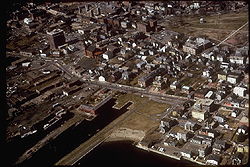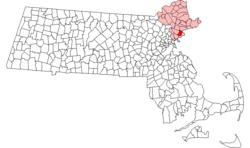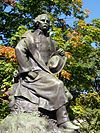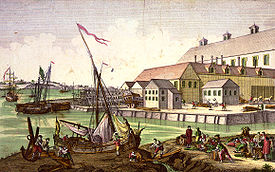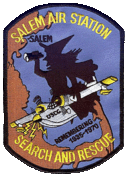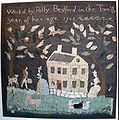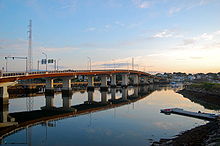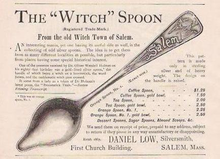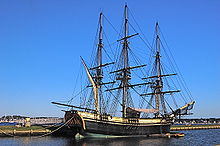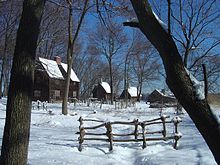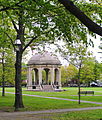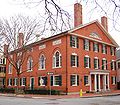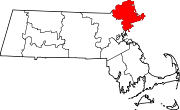- Salem, Massachusetts
-
Salem, Massachusetts — City — Salem Maritime National Historic Site 
Flag
SealNickname(s): The Witch City Motto: Divitis Indiae usque ad ultimum sinum (Latin = To the farthest port of the rich Indies) Location in Essex County in Massachusetts Coordinates: 42°31′10″N 70°53′50″W / 42.51944°N 70.89722°W Country United States State Massachusetts County Essex Settled 1626 Incorporated 1629 A City 1836 Government - Type Mayor-council city - Mayor Kimberley Driscoll Area - Total 18.1 sq mi (46.8 km2) - Land 8.1 sq mi (21.0 km2) - Water 10.0 sq mi (25.8 km2) Elevation 9 ft (3 m) Population (2007) - Total 40,922 - Density 5,052.1/sq mi (1,948.7/km2) Time zone Eastern (UTC-5) - Summer (DST) Eastern (UTC-4) ZIP code 01970 / 01971 Area code(s) 351 / 978 FIPS code 25-59105 GNIS feature ID 0614337 Website www.salem.com Salem is a city in Essex County, Massachusetts, United States. The population was 40,407 at the 2000 census. It and Lawrence are the county seats of Essex County.[1] Home to Salem State University, the Salem Willows Park and the Peabody Essex Museum, Salem is a residential and tourist area which includes the neighborhoods of Salem Neck, The Point, South Salem and North Salem, Witchcraft Heights, Pickering Wharf, and the McIntire Historic District (named after Salem's famous architect and carver, Samuel McIntire).
Salem was one of the most significant seaports in early America. It has the first National Historic Site designated by Congress, Salem Maritime National Historic Site, which protects Salem's historic waterfront.[citation needed]
Featured notably in Arthur Miller's The Crucible, much of the city's cultural identity is reflective of its role as the location of the Salem Witch Trials of 1692: Police cars are adorned with witch logos, a local public school is known as the Witchcraft Heights Elementary School, the Salem High School athletic teams are named The Witches, and Gallows Hill, a site of numerous public hangings, is currently used as a playing field for various sports.
Tourists know Salem as a mix of important historical sites, New Age and Wiccan boutiques, and kitschy Halloween or witch-themed attractions.
History
See also: Timeline of Salem, Massachusetts, historyNathaniel Hawthorne by Bela Pratt
Salem was founded at the mouth of the Naumkeag river in 1626, at the site of an ancient Native American village and trading center (it was originally called Naumkeag and was renamed Salem three years later) by a company of fishermen from Cape Ann led by Roger Conant, and incorporated in 1629. Conant’s leadership had provided the stability to survive the first two years, but he was immediately replaced by John Endecott, one of the new arrivals, by order of the Dorchester Company. Conant graciously stepped aside and was granted 200 acres (0.81 km2) of land in compensation. These “New Planters” and the “Old Planters”[2] agreed to cooperate, in large part due to the diplomacy of Conant and Endicott. In recognition of this peaceful transition to the new government, the name of the settlement was changed to Salem, a corruption of the Hebrew word שלום shalom.[3]
Naumkeag was first settled in 1626 by the Dorchester Company with Roger Conant as Governor. That settlement was located east of the present day Salem commuter rail station.
A year later, Dorchester Governor John Endecott arrived in Naumkeag and a patent was solicited by the Massachusetts Bay Company in England. Endecott moved the Great House from Cape Anne reassembling on what is now Washington Street north of Church Street.[citation needed] And a year later, the Massachusetts Bay Charter was issued creating the Massachusetts Bay Colony with Thomas Craddock as Governor and Endecott as a Governor's Assistant.[citation needed] Endecott was not Massachusetts' first Governor as some have asserted.[citation needed] A challenge to Endecott's authority in Naumkeag arose in London and was settled within the Massachusetts Bay Company in London.[citation needed] One week later, Governor John Winthrop was elected Governor and John Endecott was re-elected Governor's Assistant, followed by the Great Puritan Migration/Fleet of 1629/1630.[citation needed] Endecott's greeting of Winthrop is the subject of a plaque on the Boston Common.
In 1639, his was one of the signatures on the building contract for enlarging the meeting house in Town House Square for the First Church in Salem. This document remains part of the town records at City Hall. He was active in the affairs of the town throughout his life. Samuel Skelton was the first pastor of the First Church of Salem, MA, which is the original Puritan church in North America.[4][5] Endecott already had a close relationship with Skelton, having been converted by him, and Endecott considered him as his spiritual father.[6][7]
Roger Conant died in 1679, at the age of 87, but to celebrate this majestic life, a gigantic statue stands overlooking Salem Common. Salem originally included much of the North Shore, including Marblehead. Most of the accused in the Salem witch trials lived in nearby 'Salem Village', now known as Danvers, although a few lived on the outskirts of Salem. Salem Village also included Peabody and parts of present-day Beverly. Middleton, Topsfield, Wenham and Manchester-by-the-Sea, too, were once parts of Salem.
William Hathorne was a prosperous businessman in early Salem, and became its commanding character of the time period. He led troops to victory in King Philip's War, served as a magistrate on the highest court, and was chosen as the first speaker of the House of Deputies. He was a zealous advocate of the personal rights of freemen against royal emissaries and agents.[8][9]
Puritans had come to Massachusetts to obtain religious freedom for themselves, but had no particular interest in establishing a haven for other faiths. The laws were harsh, with punishments that included fines, deprivation of property, banishment or imprisonment. The Puritans were a significant grouping of English Protestants in the 16th and 17th centuries. Puritanism in this sense was founded by some Marian exiles from the clergy shortly after the accession of Elizabeth I of England in 1559, as an activist movement within the Church of England. The designation "Puritan" is often incorrectly used, notably based on the assumption that hedonism and puritanism are antonyms: historically, the word was used to characterize the Protestant group as extremists similar to the Cathari of France, and according to Thomas Fuller in his Church History dated back to 1564. Archbishop Matthew Parker of that time used it and "precisian" with the sense of stickler. T. D. Bozeman therefore uses instead the term precisianist in regard to the historical groups of England and New England.
One of the most widely known aspects of Salem is its history of witchcraft allegations, which started with Abigail Williams, Betty Parris, and their friends playing with a Venus glass and egg. Salem is also significant in legal history as the site of the Dorthy Talbye trial, where a mentally ill woman was hanged for murdering her daughter, because at the time Massachusetts made no distinction between insanity and criminal behavior.[10]
William Hathorne's son, Judge John Hathorne, came to prominence during this period. People generally believed witchcraft to be real. Nothing caused more fear in the Puritan community than people who appeared to be possessed by demons, and witchcraft was a serious felony. Judge Hathorne is the best known of the witch trial judges, and he became known as the "Hanging Judge" for sentencing witches to death.[11][12]
Salem & The Revolutionary War
On February 26, 1775, patriots raised the drawbridge at the North River, preventing British Colonel Alexander Leslie and his 300 troops of the 64th Regiment of Foot from seizing stores and ammunition hidden in North Salem. A few months later, in May 1775, a group of prominent merchants with ties to Salem, including Francis Cabot, William Pynchon, Thomas Barnard, E.A. Holyoke and William Pickman, felt the need to publish a statement retracting what some interpreted as Loyalist leanings and to profess their dedication to the Colonial cause.[13]
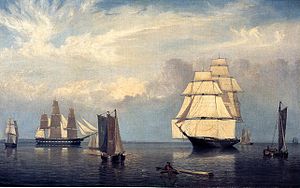 Salem Harbor, oil on canvas, Fitz Hugh Lane, 1853. Museum of Fine Arts, Boston
Salem Harbor, oil on canvas, Fitz Hugh Lane, 1853. Museum of Fine Arts, Boston
During the Revolution, the town became a center for privateering. Although the documentation is incomplete, about 1,700 Letters of Marque, issued on a per-voyage basis, were granted during the American Revolution. Nearly 800 vessels were commissioned as privateers and are credited with capturing or destroying about 600 British ships.[14] By 1790, Salem was the sixth largest city in the country, and a world famous seaport—particularly in the China trade. Codfish was exported to the West Indies and Europe. Sugar and molasses were imported from the West Indies, tea from China, and pepper from Sumatra. Salem ships also visited Africa, Russia, Japan and Australia. During the War of 1812, privateering resumed.
Prosperity left the city with a wealth of fine architecture, including Federal style mansions designed by one of America's first architects Samuel McIntire, for whom the city's largest historic district is named. These homes and mansions from Colonial America now comprise the greatest concentrations of notable pre-1900 domestic structures in the United States.
This wealth of architecture in Salem can be directly attributed to the Old China Trade, which was ongoing for years with America and Great Britain. The neutrality of the United States was tested during the Napoleonic Wars. Both Britain and France imposed trade restrictions in order to weaken each others' economies. This also had the effect of disrupting American trade and testing the United States' neutrality. As time went on, harassment by the British of American ships increased by the British Navy. This included impressment and seizures of American men and goods. After the Chesapeake Leopard Affair, Thomas Jefferson was faced with a decision to make regarding the situation at hand. In the end, he chose an economic option: the Embargo Act of 1807 and Thomas Jefferson basically closed all the ports overnight, putting a little damper on the seaport town of Salem. The embargo of 1807 was the starting point on the path to the War of 1812 with Great Britain.
Salem was incorporated as a city on March 23, 1836,[15] Salem adopted a city seal in 1839 with the motto "Divitis Indiae usque ad ultimum sinum", Latin for "To the farthest port of the rich Indies." Nathaniel Hawthorne was overseer of the port from 1846 until 1849. He worked in the Customs House [3] near Pickering Wharf, his setting for the beginning of The Scarlet Letter. In 1858, an amusement park was established at Salem Willows, a peninsula jutting into the harbor. It should be noted that up until the War of 1812, the port of Salem was a major center of trade in America.
The book "The Salem-India Story" written by Vanita Shastri narrates the adventures of the Salem seamen who connected the far corners of the globe through trade. This period (1788–1845) marks the beginning of US-India relations, long before the 21st century wave of globalization. It reveals the global trade connections that Salem had established with faraway lands, which were a source of livelihood and prosperity for many.
But shipping declined throughout the 19th century. Salem and its silting harbor were increasingly eclipsed by Boston and New York. Consequently, the city turned to manufacturing. Industries included tanneries, shoe factories and the Naumkeag Steam Cotton Company. More than 400 homes burned in the Great Salem Fire of 1914, leaving 3,500 families homeless from a blaze that began in the Korn Leather Factory. The historic concentration of Federal architecture on Chestnut Street were spared.
Air Station Salem & The National Guard
On 15 February 1935 the U.S. Coast Guard established a new seaplane facility at Salem because there was no space to expand the Gloucester Air Station at Ten Pound Island. Coast Guard Air Station Salem was located at Winter Island, an extension of Salem Neck which juts out into Salem Harbor. Search and rescue, hunting for derelicts and medical evacuations were the Station's primary areas of responsibility. During the first year of operation, Salem crews performed 26 med-evac missions. They flew in all kinds of weather and the radio direction capabilities of the aircraft were of significant value in locating vessels in distress.
During World War II, air crews from Salem flew neutrality patrols along the coast and the Air Station roster grew to 37 aircraft. Anti-submarine patrols were flown on a regular basis. In October 1944, Air Station Salem was officially designated as the first Air-Sea Rescue station on the eastern seaboard. The Martin PBM Mariner, a hold-over from the war, became the primary rescue aircraft. In the mid 1950s helicopters came as did Grumman HU-16 Albatross amphibious flying boats (UFs). Salem Harbor was deep enough to host a seadrome with three sea lanes, offering a variety of take-off headings irrespective of wind direction unless there was a strong steady wind from the east. This produced large waves that swept into the mouth of the harbor making water operations difficult. When the seadrome was too rough, returning amphibian aircraft would use Naval Auxiliary Air Facility Beverly. Salem Air Station moved to Cape Cod in 1970.
In 2011 The City of Salem made it official the plans for the tip of the 30-acre Winter Island Park [4] and squared off against residents who are against bringing two power generating windmills to the tip of Winter Island. [5] The Renewable Energy Task Force, along with Energy and Sustainability Manager Paul Marquis, have recommended the construction of a 1.5-megawatt power turbine at the tip of Winter Island, [6] which is the furthest point from residences and where the winds are the strongest. The results of the City of Salem wind tests can be viewed [7].
The nearly 30-acre park has been open to the public since the early 1970´s. In 2011 a master plan was developed with help from the planning and design firm The Cecil Group of Boston and Bioengineering Group of Salem and the City of Salem paid $45,000 in federal money. [8] In the long term the projected cost to rehabilitate just the barracks is $1.5 million. But in the short term, there are multiple lower-cost items like a proposed $15,000 for a kayak dock or $50,000 to relocate and improve the bathhouse. This is a very important project since Fort Pickering guarded Salem Harbor as far back as the 17th century.
Salem's is designated as National Guard Birthplace
In 1637 the first muster on Salem Common where for the first time, a regiment of militia drilled for the common defense of a multi-community area [9], thus laying the foundation for what became the Army National Guard.[10] Each April, the Second Corps of Cadets gather in front of St. Peter's Episcopal Church, where their founder, Stephen Abbott, is buried. They lay a wreath, play Taps and fire a 21-gun salute. In another annual commemoration, soldiers gather at Old Salem Armory to honor soldiers who were killed in the Battles of Lexington and Concord.
World Record for Federal Furniture
In 2011, a mahogany side chair with carving done by Samuel McIntire sold at auction for $662,500.[11] The price set a world record for Federal furniture. McIntyre was one of the first architects in the United States and his work represents a prime example of early Federal-style architecture. Elias Hasket Derby, Salem's wealthiest merchant and thought to be America's first millionaire, and his wife, Elizabeth Crowninshield, purchased the set of eight chairs [12] from McIntire.
The Samuel McIntire Historic District represents the greatest concentration of 17th and 18th century domestic structures anywhere in America.[citation needed] It includes McIntyre commissions such as the Peirce-Nichols House and Hamilton Hall. The Witch House or Jonathan Corwin House (circa 1642) is also located in the District. Samuel McIntyre's house and workshop were located at 31 Summer Street in what is now the Samuel McIntyre Historic District.
Film & Television in Salem
In June 1970, Bewitched filmed on location in Salem. In 2008, Bride Wars was filmed [13] in Salem and in September 2011, Rob Zombie, musician and movie director, [14] was visiting and scouting locations for his latest horror movie, "The Lords of Salem."
- Historic images of Salem
-
Roger Williams House (The Witch House) c. 1910
-
Sampler (needlework) made in Salem in 1791. Art Institute of Chicago textile collection.
Geography and transportation
Salem is located at 42°31′1″N 70°53′55″W / 42.51694°N 70.89861°W (42.516845, -70.898503).[16] According to the United States Census Bureau, the city has a total area of 18.1 square miles (47 km2), of which, 8.1 square miles (21 km2) of it is land and 9.9 square miles (26 km2) of it (55.09%) is water. Salem lies on Massachusetts Bay between Salem Harbor, which divides the city from much of neighboring Marblehead to the southeast, and Beverly Harbor, which divides the city from Beverly along with the Danvers River, which feeds into the harbor. Between the two harbors lies Salem Neck and Winter Island, which are divded from each other by Cat Cove, Smith Pool (located between the two land causeways to Winter Island) and Juniper Cove. The city is further divided by Collins Cove, and the inlet to the North River. The Forest River flows through the south end of town as well, along with Strong Water Brook, which feeds Spring Pond at the town's southwest corner. The town has several parks, as well as conservation land along the Forest River and Camp Lion, which lies east of Spring Pond.
The city is divided by its natural features into several small neighborhoods. The Salem Neck neighborhood lies northeast of downtown, and North Salem lies to the west of it, on the other side of the North River. South Salem is south of the South River, lying mostly along the banks of Salem Harbor southward. Downtown Salem lies fifteen miles (24 km) northeast of Boston, sixteen miles southwest of Gloucester and Cape Ann, and nineteen miles (30 km) southeast of Lawrence, the other county seat of Essex County. Salem is bordered by Beverly to the north, Danvers to the northwest, Peabody to the west, Lynn to the southeast, Swampscott to the south, and Marblehead to the southeast. The town's water rights extend along a channel into Massachusetts Bay between the water rights of Marblehead and Beverly.
Veterans Memorial Bridge between Salem and Beverly
The connection between Salem and Beverly is made across the Danvers River and Beverly Harbor by three bridges, the Kernwood Bridge to the west, and a railroad bridge and the Essex Bridge, from the land between Collins Cove and the North River, to the east. The Veterans Memorial Bridge carries Route 1A across the river. Route 1A passes through the eastern side of the city, through South Salem towards Swampscott. For much of its length in the city, it is coextensive with Route 114, which goes north from Marblehead before merging with Route 1A, and then heading northwest from downtown towards Lawrence. Route 107 also passes through town, entering from Lynn in the southwest corner of the city before heading towards its intersection with Route 114 and terminating at Route 1A. There is no highway access within the city; the nearest highway access to Route 128 is along Route 114 in neighboring Peabody.
Several lines of the MBTA Bus service pass through the city. Salem has a station on the Newburyport/Rockport Line of the MBTA Commuter Rail. The railroad lines are also connected to an abandoned portion of the Springfield Terminal lines which lead into Peabody, and a former line into Marblehead has been converted into a bike path.
The nearest small airport is Beverly Municipal Airport, and the nearest national and international service can be reached at Boston's Logan International Airport.
Salem Waterfront, Cruise Ship & Ferry Landing & the Blaney Street pier
Launched in 2006 with ridership climbing every year, and operated from late spring through early fall, the 92 foot Salem Ferry provides ferry service between Salem and Boston, taking less than an hour's ride.[17] In 2010, was a great success and The Salem Ferry Service between Boston's Long Wharf North and Salem's Blaney Street ran from May 28, 2010 and taking the final voyage on the 1st of November 1, 2010. The trip is 55 minutes. The ferry is enclosed, has rest rooms and a snack bar. For the 2011 season, The Salem Ferry began the 2011 season on June 11. On September 14, The Salem Ferry announced it was cutting back service and taking out the commuter service Monday to Friday because of the rise in the cost of fuel. This is the 6th year of the Salem Ferry and service will be on Friday, Saturday and Sunday with the last day of service in 2011 to be on Halloween, October 31. [15]
In October 2010, Mayor Kimberley Driscoll announced that the City will formally acquire the Blaney Street [16] parcel from Dominion Energy, paving the way for the Salem Wharf project. The City of Salem secured $1.25 million from the Massachusetts Seaport Advisory Council and $2.5 million in federal grant dollars to move forward with the construction of the project. The City acquired the parcel with the help of a $1.7 million grant received from the Seaport Advisory Council. [17]
The City of Salem's plans call for a total build-out of the current Blaney Street pier, known as the Salem Wharf project. When finished, The Blaney Street pier will be home to small to medium sized cruise ships, commercial vessels and The Salem Ferry.. This project is fully engineered and permitted. [18]. In 2010, Examples of work to be finished in this early phase that will be complete for the 2011 Season, a contractor is running underground utility cables and erecting an interim terminal building that will be used by the Salem Ferry, replacing the current trailer. The building will have an indoor bathroom — a first at the ferry landing — along with a waiting room and possibly an outdoor area with awnings. Also new for 2011 is a paved lot with about 140 parking spaces replacing the existing dirt parking lot.
Also in 2011, A Construction crews have been building a long seawall at the Blaney Street landing, which runs from the edge of the ferry dock back toward Derby Street and along an inner harbor. This is one of the early and key pieces of the Salem Pier, which the city hopes to have completed by 2014 and is the key to eventually bring cruise ships to Salem. [19]. [20]
At the end of the 2011 season of the Salem Ferry, In the late fall of 2011, after the ferry season ends, contractors will start building the first section of the T-shaped, 350-foot pier. Work on that phase is scheduled to be completed by the fall of 2012. As of April 2011, The City Of Salem has secured half of the $20 million and still needs to secure about $10 million in state and federal funds to complete this waterfront pier. [21]
Closing of the Salem Coal Plant & the 62 Acre Site.
In May 2011 and after years of legal battles, protests and one recent fatal accident has led the owner of the Salem Harbor Power Station to announce it will close down the facility permanently.[22] Dominion of Virginia says that with the approval of ISO New England, the 60-year-old coal and oil-fired plant will close for good in June 2014. [23] The City of Salem was awarded a $200,000 grant from the Clean Energy Center prior to the closure of the plant and with the closure scheduled for June 2014, this grant money is being used to plan for the eventual re-use of this property. [24] That study is underway and we are working with engineers and land use planners on re-use options. The City of Salem has been reaching out to state and federal officials to ask for their cooperation and assistance in planning for the future and money to clean up The Salem Harbor Power Plant 60 Acre Site.
Demographics
Historical populations Year Pop. ±% 1635 900 — 1765 4,427 +391.9% 1790 7,921 +78.9% 1800 9,457 +19.4% 1810 12,613 +33.4% 1820 12,731 +0.9% 1830 13,895 +9.1% 1840 15,082 +8.5% 1850 20,264 +34.4% 1860 22,252 +9.8% 1870 24,117 +8.4% 1880 27,563 +14.3% 1890 30,801 +11.7% 1900 35,956 +16.7% 1910 43,697 +21.5% 1920 42,529 −2.7% 1930 43,353 +1.9% 1940 41,213 −4.9% 1950 41,880 +1.6% 1960 39,211 −6.4% 1970 40,556 +3.4% 1980 38,220 −5.8% 1990 38,091 −0.3% 2000 40,407 +6.1% 2001* 40,688 +0.7% 2002* 41,588 +2.2% 2003* 41,406 −0.4% 2004* 41,630 +0.5% 2005* 41,840 +0.5% 2006* 41,671 −0.4% 2007* 41,421 −0.6% 2008* 41,437 +0.0% 2009* 41,361 −0.2% 2010 41,340 −0.1% * = population estimate.
Source: United States Census records and Population Estimates Program data.[18][19][20][21][22][23][24][25][26][27][28]As of the census[29] of 2010, there were 41,340 people, 19,130 households, and 9,708 families residing in the city. The population density was 4,986.0 people per square mile (1,926.1/km²). There were 18,175 housing units at an average density of 2,242.7 per square mile (866.3/km²). The racial makeup of the city was 75.9% White, 4.9% African American, 0.22% Native American, 2.6% Asian, 0.05% Pacific Islander, 6.74% from other races, and 2.47% from two or more races. Hispanic or Latino of any race were 15.6% of the population.
There were 17,492 households out of which 24.2% had children under the age of 18 living with them, 38.8% were married couples living together, 13.3% had a female householder with no husband present, and 44.5% were non-families. 34.9% of all households were made up of individuals and 11.5% had someone living alone who was 65 years of age or older. The average household size was 2.24 and the average family size was 2.95.
In the city the population was spread out with 20.2% under the age of 18, 10.4% from 18 to 24, 33.4% from 25 to 44, 21.9% from 45 to 64, and 14.1% who were 65 years of age or older. The median age was 36 years. For every 100 females there were 86.5 males. For every 100 females age 18 and over, there were 83.5 males.
The median income for a household in the city was $44,033, and the median income for a family was $55,635. Males had a median income of $38,563 versus $31,374 for females. The per capita income for the city was $23,857. About 6.3% of families and 9.7% of the population were below the poverty line, including 12.2% of those under age 18 and 7.9% of those age 65 or over.
Education
 Logo of Salem State University
Logo of Salem State University
Salem State University is the largest of the nine schools comprising the state university system in Massachusetts (the five University of Massachusetts campuses are a separate system), with 7,500 undergraduates and 2,500 graduate students;[30] its five campuses encompass 115 acres (0.47 km2) and include 33 buildings. The Salem State Foundation hosts an annual lecture series, featuring high-profile speakers from around the world.[31]
The university was founded in 1854 as the Salem Normal School (for teacher training) based on the educational principles espoused by Horace Mann, considered to be the "Father of American Public Education."[32]
Salem State University enrolls over 10,000 undergraduate and graduate students representing 27 states and 57 foreign countries, and is one of the largest state universities in the Commonwealth of Massachusetts. The university also offers Continuing Education courses for credit or non-credit. Situated on five campuses totaling 115 acres (0.47 km2). Currently, the university houses 2,000 students in its five residence facilities.
Public elementary schools include the Bates, Bentley, Carlton, Horace Mann, Nathaniel Bowditch, Saltonstall and Witchcraft Heights schools. Collins Middle School, Nathaniel Bowditch School, and Salem High School are located on Highland Avenue. Private schools are also located in the city, including two independent, alternative schools, The Phoenix School and the Greenhouse, as well as the Salem Academy Charter School.
Salem also once had a very strong Roman Catholic school system. Once home to almost a dozen schools, the last school in the city, St. Joseph School, closed in July 2009 after over 100 years of providing Catholic Education. St. James High School, St. Chretienne Academy, St. Chretienne Grammar School and St. Mary's School closed in 1971, St. James Grammar School closed in 1972, St. Thomas the Apostle School closed in 1973, St. Anne School closed in 1976, St. John the Baptist School closed in 1977 and St. Joseph High School closed in 1980.[33]
In late 2007 and early 2008, the city's public school system garnered regional and even national attention after officials announced a $4.7 million budget shortfall that threatened the jobs of teachers and other staff members. The Massachusetts General Court passed legislation, and residents raised enough money, that averted teacher layoffs. Several dozen support workers were still laid off.[34] Police were investigating what happened to the money in a search for criminal violations of the law.[35]
Tourism
See also: Chestnut Street District for Historic Districts in Salem
Historic Homes
The Pickman House, built circa 1664, abuts the Witch Memorial and Burying Point Cemetery, the second oldest burying ground in the United States.
The Gedney House is a historic house museum built circa 1665 and is the 2nd oldest house in Salem.
One of the most popular houses in Salem is The Witch House, the only structure in Salem with direct ties to the Salem Witch Trials of 1692. The Witch House is owned and operated by the City of Salem as a historic house museum.[25]
Hamilton Hall (Salem, Massachusetts) is located on Chestnut Street in Salem, where many grand mansions can be traced to the roots of the Old China Trade. Hamilton Hall was built in 1805 by Samuel McIntire and is considered one of McIntire best pieces. It was declared a National Historic Landmark by the National Park Service in 1970.
Witch Related Tourism
Tourism is the backbone of Salem's economy, followed by Salem State University with over 10,000 students. Tourism based on the 1692 witch trials dates back to at least the first half of the 20th century, when dry goods merchant Daniel Low sold souvenir spoons with witch images. Such tourism expanded significantly in the 1970s, when the television situation comedy Bewitched filmed several episodes here.[36] Witch-related tourism expanded significantly in the 1990s, and the city added an official "Haunted Happenings" celebration during the October tourist season.
In 2007, the city launched the Haunted Passport program which offers visitors discounts and benefits from local tourist attractions and retailers from October to April.[37] The goal of the program is to get visitors to come back to Salem after Halloween and experience businesses that may not be directly tied to Halloween. Thousands watched in 2007 as Mayor Kim Driscoll started a new trend with a massive fireworks display that kicked off at 10:00 pm on Halloween.[38]
In recent years, tourism has been an occasional source of debate in the city, with some residents arguing the city should downplay witch tourism and market itself as a more upscale cultural center. In 2005, the conflict came to a head over plans by the cable television network TV Land to erect a bronze statue of Elizabeth Montgomery, who played the comic witch "Samantha" in the 1960s series Bewitched.[36] A few special episodes of the series were actually filmed in Salem, and TV Land said that the statue commemorated the 35th anniversary of those episodes. The statue was sculpted by StudioEIS under the direction of brothers Elliott and Ivan Schwartz. Many felt the statue was good fun and appropriate to a city that promotes itself as "The Witch City", and contains a street named "Witch Way". Others objected to the use of public property for what was transparently commercial promotion.[39]
Other tourist attractions
The Friendship replica docked off of Derby Street
In 2000, the replica tall ship Friendship of Salem was finished and sailed to Salem Harbor, where she sits today. The Friendship of Salem is a reconstruction of a 171-foot (52 m) three-masted East Indiaman trading ship, originally built in 1797, which traveled the world over a dozen times and returned to Salem after each voyage with goods from all over the world. The original was taken by the British during the War of 1812, then stripped and sold in pieces.[40]
In 2006, with the assistance of a 1.6 million dollar grant and additional funds provided by the City of Salem,[citation needed] Mayor Driscoll launched The Nathaniel Bowditch, a 92-foot catamaran with a top speed of 30 knots which makes the trip between Salem and Boston in just under an hour. Bowditch, who was born in Salem and had a home on North Street, is considered the founder of modern maritime navigation. His book, Bowditch's American Practical Navigator, first published in 1802, is still carried on board every commissioned U.S. Naval vessel.[citation needed]
The original Fame was a fast Chebacco fishing schooner that was reborn as a privateer when war broke out in the summer of 1812. She was arguably the first American privateer to bring home a prize, and she made 20 more captures before being wrecked in the Bay of Fundy in 1814.
The new Fame is a full-scale replica of this famous schooner. Framed and planked of white oak and trunnel-fastened in the traditional manner, the replica of Fame was launched in 2003. She is now based at Salem's Pickering Wharf Marina, where she takes the paying public for cruises on historic Salem Sound. [26]
Salem Harborwalk opened in July 2010 to celebrate the rebirth of the Salem Waterfront as a source of recreation for visitors as well as the local community. The 1,100 foot walkway from the area of the Salem Fire Station to the Salem Waterfront Hotel.[41][42]
The Peabody Essex Museum is a leading museum of Asian art and culture and early American maritime trade and whaling; its collections of Indian, Japanese, Korean, and Chinese art, and in particular Chinese export porcelain, are among the finest in the country. Founded in 1799, it is the oldest continuously operating museum in the United States.[43] The museum owns and exhibits a number of historic houses in downtown Salem. In 2003, it completed a massive $100 million dollar renovation and expansion, designed by architect Moshe Safdie, and moved a 200-year-old 16-room Chinese home from Xiuning County in southeastern China to the grounds of the museum.[44]
The Pioneer Village, created in 1930, was America's first living-history museum. The site features a three-acre re-creation of a Puritan village and allows visitors the opportunity to participate in activities from the lives of Salem's earliest English settlers.[45]
The Old Salem Jail, an active correctional facility until 1991, once housed captured British soldiers from the War of 1812. It contains the main jail building (built in 1813, renovated in 1884), the jail keeper's house (1813) and a barn (also about 1813). The jail was shuttered in 1991 when Essex County opened its new facility in Middleton. In 2010, a $12 million renovation was completed.[46] One feature of the reconstruction is the jail keeper's house, a three-story brick, Federal-period building originally built in 1813. The project went into a long phase of stagnation when in 1999 the county government was dissolved, resulting in the sale of Salem Jail by the Commonwealth of Massachusetts to the City of Salem for $1.[47] The Old Salem Jail complex was renamed 50 Saint Peter Street and is now private property, with private residences.[48]
Points of interest
- Nathaniel Bowditch House (c. 1805) Founder of modern navigation
- Crowninshield-Bentley House (c. 1727–30)
- John Tucker Daland House (1851)
- Gedney House One of the oldest homes in Salem, open for tours! Located on High Street and Summer Street Salem (c. 1665)
- Nathaniel Hawthorne Birthplace (c. 1730–45)
- House of the Seven Gables (1668)
- The Witch House, the home of Salem Witch Trials investigator Jonathan Corwin, and the only building still standing in Salem with direct ties to the Witch Trials
- Salem Common
- Misery Islands
- Peabody Essex Museum (1799) Oldest continually operated museum in America.
- Derby Square Tours Founded in 1983 by Jim McAllister, Night Tour, Witch Trial Trail & Terror Trail the longest running walking tour company in Salem.
- Winter Island Maritime Park, RV camping seasonally.
- Phillips Library
- Salem Willows Motor home and RV parking .
- Stephen Phillips Memorial Trust House (1800 & 1821)
- Pickering House, Broad Street (c. 1651)
- Salem Architecture from the 17th and 18th Centuries
- Ropes Mansion (late 1720s)
- McIntire Historic District, greatest concentration of 17th and 18th century domestic structures in the U.S.
- Salem Maritime National Historic Site, the only remaining intact waterfront from the U.S. age of sail
- Pioneer Village, Forest River Park (c. 1930)
- Salem Willows Park (1858), a small oceanfront amusement park.
- Joseph Story House
- Winter Island, park and historic point of the U.S. Coast Guard in WW2 for U-boat patrol
- Salem Athenaeum
- Salem Points of Interest
-
Salem Common bandshell in 2005
Notable residents
- Nehemiah Adams (1806–1878), clergyman and author
- Brunonia Barry, author of The Lace Reader
- Frank Weston Benson (1862–1951), impressionist artist
- John Prentiss Benson (1865–1947), architect and maritime artist
- William Bentley (1759–1819), Unitarian Minister, Salem diarist
- Samuel Bowden, Medal of Honor recipient for gallantry in Indian Wars at Wichita River, Texas, 5 October 1870.[49]
- Nathaniel Bowditch (1773–1838), mathematician and navigator
- Rick Brunson, former NBA player
- Timothy Burgess, veterinarian and zoologist
- Laurie Cabot, Witchcraft high priestess
- Christian Day Witchcraft high priest and owner of two local stores.
- Robert Ellis Cahill (1934–2005), sheriff, historian and author
- Roger Conant (c.1592–1679), founder of Salem
- Crowninshield family, Boston Brahmins who later helped settle Salem
- Elias Hasket Derby (1739–1799), merchant, first millionaire[50]
- Joseph Horace Eaton (1815–1896), artist and military officer
- John Endecott (1588–1665), governor
- Thomas Gardner (planter) (c.1592–1674), co-founder of Salem
- John Hathorne (1641–1717), the "Hanging Judge" in Salem witch trials
- William Hathorne (c. 1576–1650), early businessman and political leader
- Nathaniel Hawthorne (1804–1864), writer
- Jeff Juden, major league baseball pitcher
- Frederick W. Lander (1821–1862), Civil War General, wagon trail and railroad surveyor, poet
- John Larch, actor (1914–2005),
- Dudley Leavitt (1720–1762), early Harvard-educated Congregational minister,[51] New Hampshire native, married to Mary Pickering,[52] Salem's Leavitt Street named for him[53]
- Mary Lou Lord singer/songwriter grew up in Salem
- Samuel McIntire (1757–1811), architect & woodcarver.
- Rob Oppenheim, professional golfer
- Charles Grafton Page (1812–1868), electrical inventor.
- George Swinnerton Parker (1866–1952), founder of Parker Brothers
- Samuel Parris (1653–1720), minister
- Timothy Pickering (1745–1829), secretary of state
- Benjamin Pickman (1763–1843), early Salem merchant for whom Salem's Pickman Street is named[54]
- Dudley Leavitt Pickman, (1779–1846), state legislator,[55] Salem merchant, partner, Devereux, Pickman & Silsbee,[56] wealthiest Salem merchant of his day[57][58]
- Sarah Parker Remond (1826–1894), abolitionist
- Aaron Richmond (1895–1965), impresario and artist manager
- Brian St. Pierre, quarterback for the Carolina Panthers
- Samuel Sewall (1652–1730), magistrate
- Samuel Skelton (c. 1584–1634), first pastor of the First Church in Salem, MA, the original Puritan church in North America
- Steve Thomas, former host of PBS's "This Old House"
- Bob Vila, craftsman
- Jack Welch, former chairman and CEO of General Electric grew up in Salem and attended Salem High School
- Roger Williams (1603–1683), theologian
- Notable Residents of Salem
Sister cities
 - Oroville, California (USA) 2007[59]
- Oroville, California (USA) 2007[59] - Ōta, Tokyo (Japan) 1991[60]
- Ōta, Tokyo (Japan) 1991[60]
Notes
- ^ "Find a County". National Association of Counties. http://www.naco.org/Counties/Pages/FindACounty.aspx. Retrieved 2011-06-07.
- ^ The four Old Planters are John Balch, Roger Conant, Peter Palfrey & John Woodbury -Crawford, Mary Caroline,. Famous families of Massachusetts. Boston: Little, Brown, and Co., 1930. Chap 6
- ^ Richard Gildrie, Salem Massachusetts 1626-1683, 4.
- ^ Barz-Snell, Rev. Jeffrey, "A 'Short' History of the First Church in Salem," First Church in Salem, Unitarian Web Site (http://www.firstchurchinsalem.org/longhistory22.html), Retrieved 4 Feb. 2011.
- ^ Marsh, D. W., Ed., Genealogy of the Marsh Family Outline for Five Generations, p. 1, Press of J. R. Williams, Amherst, MA, 1886.
- ^ Upham, William Phineas, Papers Relating to the Rev. Samuel Skelton, 1875.
- ^ Harrison, Bruce H., The Family Forest Descendants of Rev. Samuel Skelton, p. 4, Millisecond Publishing Co., Inc., Kamuela, HI, 2004.
- ^ Soldiers in King Philip's War, Chapt. 22 (http://www.usgennet.org/usa/topic/newengland/philip/21-end/ch22.html)
- ^ Anderson, Robert, The Great Migration Begins: Immigrants to New England, 1620-1633, Entry for William Hathorne, New England Historic Genealogical Society, Boston, MA, 1999.
- ^ Albert Christophe. The Romantic Story of the Puritan Fathers: And Their Founding of NewBoston. http://books.google.com/books?id=648_AAAAMAAJ&pg=PA131&lpg=PA131&dq=dorothy+talbye&source=web&ots=3yh_eFoua8&sig=gTpgLoNymx_uf9umOuCnSXtz19o#PPR5,M1. Retrieved 2007-11-14.
- ^ Starkey, Marion, The Devil in Massachusetts, Knopf, Doubleday, 1969.
- ^ Brief Biography of John Hathorne, Hawthorne in Salem Web site (http://www.hawthorneinsalem.org/Life&Times/Family/Paternal/Introduction.html#JohnHathorne).
- ^ The Loyalists of Massachusetts and the Other Side of the American Revolution, James H. Stark, James H. Stark, Boston, 1910
- ^ John Fraylor. Salem Maritime National Historic Park http://www.nps.gov/revwar/about_the_revolution/privateers.html
- ^ Salem history
- ^ "US Gazetteer files: 2010, 2000, and 1990". United States Census Bureau. 2011-02-12. http://www.census.gov/geo/www/gazetteer/gazette.html. Retrieved 2011-04-23.
- ^ The Salem Ferry
- ^ "TOTAL POPULATION (P1), 2010 Census Summary File 1, All County Subdivisions within Massachusetts". United States Census Bureau. http://factfinder2.census.gov/bkmk/table/1.0/en/DEC/10_SF1/P1/0400000US25.06000. Retrieved September 13, 2011.
- ^ "Massachusetts by Place and County Subdivision - GCT-T1. Population Estimates". United States Census Bureau. http://factfinder.census.gov/servlet/GCTTable?_bm=y&-geo_id=04000US25&-_box_head_nbr=GCT-T1&-ds_name=PEP_2009_EST&-_lang=en&-format=ST-9&-_sse=on. Retrieved July 12, 2011.
- ^ "1990 Census of Population, General Population Characteristics: Massachusetts". US Census Bureau. December 1990. Table 76: General Characteristics of Persons, Households, and Families: 1990. 1990 CP-1-23. http://www.census.gov/prod/cen1990/cp1/cp-1-23.pdf. Retrieved July 12, 2011.
- ^ "1980 Census of the Population, Number of Inhabitants: Massachusetts". US Census Bureau. December 1981. Table 4. Populations of County Subdivisions: 1960 to 1980. PC80-1-A23. http://www2.census.gov/prod2/decennial/documents/1980a_maABC-01.pdf. Retrieved July 12, 2011.
- ^ "1950 Census of Population". Bureau of the Census. 1952. Section 6, Pages 21-10 and 21-11, Massachusetts Table 6. Population of Counties by Minor Civil Divisions: 1930 to 1950. http://www2.census.gov/prod2/decennial/documents/23761117v1ch06.pdf. Retrieved July 12, 2011.
- ^ "1920 Census of Population". Bureau of the Census. Number of Inhabitants, by Counties and Minor Civil Divisions. Pages 21-5 through 21-7. Massachusetts Table 2. Population of Counties by Minor Civil Divisions: 1920, 1910, and 1920. http://www2.census.gov/prod2/decennial/documents/41084506no553ch2.pdf. Retrieved July 12, 2011.
- ^ "1890 Census of the Population". Department of the Interior, Census Office. Pages 179 through 182. Massachusetts Table 5. Population of States and Territories by Minor Civil Divisions: 1880 and 1890. http://www2.census.gov/prod2/decennial/documents/41084506no553ch2.pdf. Retrieved July 12, 2011.
- ^ "1870 Census of the Population". Department of the Interior, Census Office. 1872. Pages 217 through 220. Table IX. Population of Minor Civil Divisions, &c. Massachusetts. http://www2.census.gov/prod2/decennial/documents/1870e-05.pdf. Retrieved July 12, 2011.
- ^ "1860 Census". Department of the Interior, Census Office. 1864. Pages 220 through 226. State of Massachusetts Table No. 3. Populations of Cities, Towns, &c.. http://www2.census.gov/prod2/decennial/documents/1860a-08.pdf. Retrieved July 12, 2011.
- ^ "1850 Census". Department of the Interior, Census Office. 1854. Pages 338 through 393. Populations of Cities, Towns, &c.. http://www2.census.gov/prod2/decennial/documents/1850c-11.pdf. Retrieved July 12, 2011.
- ^ "1950 Census of Population". Bureau of the Census. 1952. Section 6, Pages 21-7 through 21-09, Massachusetts Table 4. Population of Urban Places of 10,000 or more from Earliest Census to 1920. http://www2.census.gov/prod2/decennial/documents/23761117v1ch06.pdf. Retrieved July 12, 2011.
- ^ "American FactFinder". United States Census Bureau. http://factfinder.census.gov. Retrieved 2008-01-31.
- ^ "Salem State University: Facts and Figures". Salem, Massachusetts: Salem State University. 2010. http://www.salemstate.edu/about/facts.php. Retrieved April 28, 2011.
- ^ "Salem State University Series". Salem, Massachusetts: Salem State University. 2011. http://www.salemstate.edu/6081.php. Retrieved April 28, 2011.
- ^ "History of Salem State University". Salem, Massachusetts: Salem State University. 2011. http://www.salemstate.edu/about/history.php. Retrieved April 28, 2011.
- ^ Salem News
- ^ Salem News
- ^ Salem News
- ^ a b Brooks, Anthony (May 5, 2005). "Salem Residents Oppose Planned 'Bewitched' Statue". National Public Radio. http://www.npr.org/templates/story/story.php?storyId=4632488. Retrieved April 28, 2011.
- ^ Cassidy, Chris (July 11, 2007). "Could Halloween 'passport' scare up year-round profits?". The Salem News (Community Newspaper Holdings, Inc.). http://www.salemnews.com/local/x1150867667/Could-Halloween-passport-scare-up-year-round-profits. Retrieved April 28, 2011.
- ^ Guerriero, Lisa (September 13, 2007). "Carnival, fireworks added to Halloween offerings; more plans brewing". Salem Gazette (GateHouse Media, Inc.). http://www.wickedlocal.com/salem/news/business/x1681065367#axzz1KqwbTVMT. Retrieved April 28, 2011.
- ^ Matarazzo, Jr., Bruno (July 20, 2006). "Controversial'Bewitched'statue besmirched by red paint". The Salem News (Community Newspaper Holdings, Inc.). http://www.salemnews.com/local/x1150790323/ControversialBewitchedstatue-besmirched-by-red-paint. Retrieved April 28, 2011.
- ^ "Friendship Overview". Salem, Massachusetts: salemweb.com. http://www.salemweb.com/frndship/. Retrieved April 28, 2011.
- ^ Galang, Stacie N. (July 16, 2010). "Salem Harborwalk opens amid appreciative crowd". The Salem News (Community Newspaper Holdings, Inc.). http://www.salemnews.com/local/x540035125/Salem-Harborwalk-opens-amid-appreciative-crowd. Retrieved April 28, 2011.
- ^ Glasset, Meaghan (November 8, 2007). "Grants will transform Peabody Street lot into park, harbor walk destination". Salem Gazette (GateHouse Media, Inc.). http://www.wickedlocal.com/salem/news/x9493533#axzz1KqwbTVMT. Retrieved April 28, 2011.
- ^ "About PEM". Salem, Massachusetts: Peabody Essex Museum. http://www.pem.org/about/director. Retrieved April 28, 2011.
- ^ Yin Yu Tang
- ^ "Pioneer Village: Salem 1630". Salem, Massachusetts: salemweb.com. http://www.salemweb.com/tales/pioneervillage.shtml. Retrieved April 28, 2011.
- ^ Dalton, Tom (March 24, 2010). "Salem Jail to hold first open house". The Salem News (Community Newspaper Holdings, Inc.). http://www.salemnews.com/local/x1690090117/Salem-Jail-to-hold-first-open-house. Retrieved April 28, 2011.
- ^ Dalton, Tom (April 22, 2009). "Work set to begin at old jail". The Salem News (Community Newspaper Holdings, Inc.). http://www.salemnews.com/local/x1690075494/Work-set-to-begin-at-old-jail. Retrieved April 28, 2011.
- ^ Dalton, Tom (July 19, 2010). "Access to public an issue at old jail". The Salem News (Community Newspaper Holdings, Inc.). http://www.salemnews.com/local/x1601577688/Access-to-public-an-issue-at-old-jail. Retrieved April 28, 2011.
- ^ "Medal of Honor recipients". United States Army. http://www.history.army.mil/html/moh/indianwars.html. Retrieved 2010-11-19.
- ^ Hasket Derby Pickman, Harvard College class of 1815 and son of Col. Benjamin Pickman Esq. and his wife Anstiss Derby, daughter of merchant Elias Hasket Derby and his wife Elizabeth Crowninshield, died the year he graduated from Harvard.[1]
- ^ The Native Ministry of New Hampshire, Nathan Franklin Carter, Rumford Printing Co., Concord, N.H., 1906
- ^ The Life of Timothy Pickering, Vol. II, Octavius Pickering, Charles Wentworth Upham, Little, Brown & Co., Boston, 1873
- ^ Leavitt was minister of a splinter church of Salem's First Church. Upon Leavitt's untimely death in 1762, the church elected to call itself 'the Church of which the Rev. Mr. Dudley Leavitt was late Pastor.'[2]
- ^ Naturalization papers of Benjamin Pickman, Dudley Leavitt Pickman Papers, Phillips Library Collection, Peabody Essex Museum, pem.org/museum
- ^ Acts and Resolves Passed by the General Court, Russell, Cutler & Co., Boston, 1812-1815
- ^ George Nichols, Salem Shipmaster and Merchant, George Nichols, Martha Nichols, Reprinted by Ayers Publishing, 1970
- ^ Yankee India: American Commercial and Cultural Encounters with India in the Age of Sail, 1784–1860, Susan S. Bean, Peabody Essex Museum, Published by Peabody Essex Museum, 2001
- ^ History of Essex County, Massachusetts, Vol. I, Douglas Hamilton Hurd, J.W. Lewis & Co., Philadelphia, 1888
- ^ Chico considers establishing permanent sister city guidelines - Chico Enterprise Record
- ^ This resulted from the affiliation between Salem's Peabody Essex Museum (PEM) and the Ota Folk Museum in Japan.
References
- Perley, Sidney. History of Salem, Massachusetts in Three Volumes. Full images at University of Virginia eText Center and the Salem Witch Trial Documentary Archive and Transcription Project.
- 1795 Map of Salem.
- Saunders, Jonathan P. 1832 Map of Salem.
- Beer, D.G. 1872 Atlas of Essex County Map of Salem. Plate 118.
- Walker, George H. 1884 Atlas of Essex County Salem South. Plate 16. Salem-Jail-to-hold-first-open-houseSalem North. Plate 17.
- Various Salem Atlases.
- Hopkins, C.M. Atlas of Salem, Massachusetts. Published in 1874.
- Sanborn Map Co. Map of Salem Showing Area Destroyed by Fire June 25, 1914.
- Atlas of Salem for 1890-1903 Index Map. Page selection.
- 1897 Atlas of Salem Massachusetts Index Map.
- Walker. 1911 Atlas of Salem, Massachusetts.
- Salem 1906-1938 Index or Key Map.
- Vital Records of Salem, Massachusetts to 1849. Published 1916, 1918, 1924, 1925. Transcribed and put online by John Slaugher.
Further reading
- Richard J. Morris. Redefining the Economic Elite in Salem, Massachusetts, 1759-1799: A Tale of Evolution, Not Revolution. The New England Quarterly, Vol. 73, No. 4 (Dec., 2000), pp. 603–624.
- In the Devil's Snare: The Salem Witchcraft Crisis of 1692, Mary Beth Norton, Knopf, 2002, hardcover, 432 pages, ISBN 0-375-40709-X
External links
- City of Salem
- City of Salem Facebook Page
- A multimedia walking tour of Salem
- Salem Public Library
- The First Church in Salem
- SalemWeb
- Salem Police Department
- Stephen Phillips Memorial Trust House
- This Week in Salem History
- History of the Salem Common
- The Bewitched Statue of Salem MA
- Salem Old Town Hall
- Salem Pioneer Village
Coordinates: 42°31′01″N 70°53′55″W / 42.516845°N 70.898503°W
Municipalities and communities of Essex County, Massachusetts Cities Amesbury | Beverly | Gloucester | Haverhill | Lawrence | Lynn | Methuen | Newburyport | Peabody | Salem
Towns Andover | Boxford | Danvers | Essex | Georgetown | Groveland | Hamilton | Ipswich | Lynnfield | Manchester-by-the-Sea | Marblehead | Merrimac | Middleton | Nahant | Newbury | North Andover | Rockport | Rowley | Salisbury | Saugus | Swampscott | Topsfield | Wenham | West Newbury
CDPs Other
villagesAnnisquam | Ballardvale | Beverly Farms | Bradford | Byfield | Clifton | Plum Island
Categories:- Salem, Massachusetts
- Cities in Massachusetts
- Populated coastal places in Massachusetts
- Witchcraft
- Populated places established in 1626
- County seats in Massachusetts
- Salem witch trials
Wikimedia Foundation. 2010.

